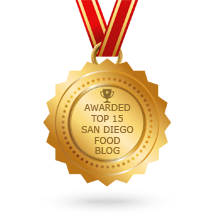Bliss & Baker's Elevated Rice Crispie Treats
And Rice Krispies treats. Everyone made them. Sticky, gooey, with a little bit of crunch. Easy to make. What's not to love about them?
So when I heard that about a year ago a San Marcos mother and daughter had launched a business to make them, I thought, yeah, really? I mean why not make them myself? Or buy them at Starbucks or some other coffee house or even at the market?
It wasn't until I saw what they were up to--or more precisely tasted what they were up to--that I got it. These small batch treats are good. They turn up the volume on a cherished childhood memory.
Laura and Natalie Potter are the team behind what they've named Bliss & Baker. Just one year ago they started making their treats, which you can eat as snacks, but also chop into ice cream--or even use to make extravagant s'mores.
"Mom always made them when we were growing up," recalls daughter Natalie. "It was something we thought we could play around with."
Mom Laura says that she used to dip the squares in chocolate and bring them to parties. She's always been a big baker and, in fact, used to enter the Pillsbury Bake-Off, even competing one year. She also wanted to start her own business after years of being a stay-at-home mom to Natalie and son Stephen. And how perfect to be in business with her daughter, who also loves to bake and, at 21, is in her last semester of college at Cal State San Marcos studying sociology?
The two started testing flavors and eventually came up with six: Salty Caramel, El Churro, Peppymint, Peanut Butter, Coconut Caramel, Sugar Cookie, and gluten-free Brown Rice Salty Caramel. They also create seasonal, holiday, and specialty flavors throughout the year.
Yes, they use Rice Krispies cereal and marshmallows. They tried some organic versions but the flavors and textures just didn't work out. And they tried making their own marshmallows but, according to Laura, they didn't work out texturally and they needed to keep costs down to make the treats affordable.
But, Laura notes, they use some local purveyors, like La Jolla Sea Salts and San Marcos' Hollandia Dairy Cream. Yeah, the dairy itself is no longer there but she has fond childhood memories of visiting it and is trying to stay local. And, because she knows some of our local dairies are part of the Challenge cooperative, Bliss & Baker also uses their butter.
I tried four of the flavors. My favorite was the Salty Caramel. Laura and Natalie make their own caramel and that mashup of sweet and savory really appealed to me. The El Churro, with its sweet cinnamon flavor was also terrific. And while I'm not a huge peanut butter person, I was surprisingly taken by that variety. They use a generous amount of peanut butter so you really get that gooey, salty, nuttiness combined with the Rice Krispies. To be honest I was less wowed by the Sugar Cookie. That would really appeal to a child, but for me it was just a bit too sweet.
No chocolate? Yeah, I'm disappointed, too, but, said the women, they found it was just too difficult to control the quality of the chocolate when packaging and shipping it--especially since they don't add any preservatives.
With the name Bliss & Baker, they've given themselves room to grow beyond the Crispies. Like a really great brownie. "And I've got bread pudding on my mind," says Laura. They're also working on new varieties of Crispies, including a Whiskey Crispie, adding Maker's Mark to their caramel. And a yet-to-be-determined flavor with an Italian spin.
Their ultimate goal is to open a storefront, perhaps in downtown San Diego. But today, you can find their Crispies at El Pescador Fish Market and Green Acre at Campus Pointe, as well as online. They'll also be at the Williams-Sonoma Artisans' Market in Fashion Valley on March 19 and on March 24th, will be participating in a pop up at Solace & the Moonlight Lounge to benefit the North Coast Unit--Rady Children's Hospital Auxiliary.
Print Page

































